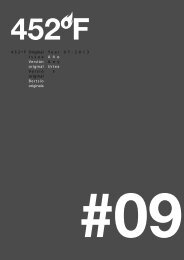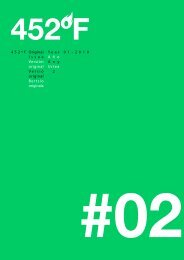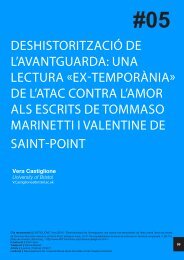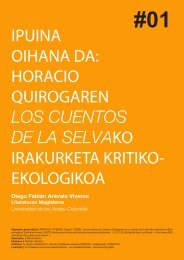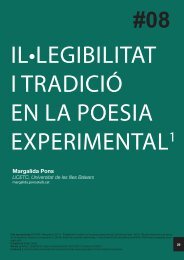03 - 452ºF
03 - 452ºF
03 - 452ºF
Create successful ePaper yourself
Turn your PDF publications into a flip-book with our unique Google optimized e-Paper software.
her aloof mother. This unhappy family situation supplies the tenor<br />
of the novel and inspires Lallia to seek friendship and love outside<br />
the home. Since Lallia’s liaison with René operates as the leitmotif<br />
of the novel, I have decided to focus my analysis on the figure of the<br />
Cowboy and their doomed friendship in the context of the Algerian<br />
War of Independence.<br />
1. Revolution: The novel’s violent context<br />
The Algerian National Liberation Front (FLN) declared war against<br />
France on November 1, 1954 but the independence struggle did not<br />
reach its climax for two more years. Raging on for eight years the<br />
Algerian Revolution took the form of a kind of guerrilla warfare in the<br />
rough wilderness of the countryside. At its most effective between<br />
1956 and 1957, the National Liberation Army (ALN) reached its peak<br />
membership with approximately 60,000 men. Smuggling arms and<br />
supplies across the borders with Morocco and Tunisia, the Army<br />
made successful attacks on French forces until the construction of<br />
barriers and increased border control along the Morice Line in 1957<br />
and 1958. In a departure from its rural campaign, the FLN’s Battle of<br />
Algiers unfolded in the capital city in 1957 1 . While the French were<br />
ultimately successful in their urban campaign against the FLN, the<br />
Battle of Algiers marked a grave moral crisis for France and exposed<br />
its widespread use of torture against suspects. Exposés like Henri<br />
Alleg’s La Question (1958) on his experience of torture at the hands<br />
of the French appeared in the métropole and were quickly censored<br />
by the government.<br />
General de Gaulle’s return to power in 1958 marked the beginning of<br />
the end of the Algerian Revolution. While the war continued for four<br />
more years, France’s new leader began to take steps to negotiate<br />
with the FLN. Around this time, the Provisional Government of the<br />
Algerian Republic (GPRA) was formed by the FLN with Ferhat<br />
Abbas at its helm and the following year the ALN general staff was<br />
organized around Colonel Boumediene. These two entities were<br />
meant to work in tandem, complimenting one another; however, this<br />
relationship shifted dramatically with the country’s independence in<br />
1962. The negotiations with France solidified the FLN’s hegemony<br />
as the «rightful leader» of Algeria and it continued to construct its<br />
heroic story to reinforce this impression. Disguised as the sole party<br />
of the populist struggle, the FLN disseminated its version of events<br />
through the nationalist newspaper, El Moudjahid. The notion that<br />
the Revolution would transform the Algerian people and make them<br />
«one» was propagated by supporters of the FLN, including Frantz<br />
Fanon who declared that oppressed people everywhere must unite<br />
and shake off the colonial yoke in the same manner as the Algerians<br />
NOTES<br />
1 | The designation «Battle<br />
of Algiers» refers to the<br />
approximate period between<br />
January and September<br />
1957. It is widely contested by<br />
historians since a heightened<br />
level of urban violence<br />
preceded and followed this<br />
specific interval of time. Hence<br />
the designation is considered<br />
arbitrary. Examples of high<br />
profile terrorist attacks that<br />
preceded the Battle of Algiers<br />
include the widespread<br />
guerrilla attacks following the<br />
execution of Ahmed Zabane<br />
and Abdelkader Ferradj in<br />
June 1956 at Barberousse, the<br />
explosion at rue de Thèbes<br />
in the Casbah in August 1956<br />
and the bombings at the Milk<br />
Bar, the Cafétéria as well as a<br />
failed attempt at the Air France<br />
terminus in September 1956.<br />
These three bomb attacks<br />
were undertaken by fidayate<br />
Zohra Drif, Samia Lakhdari and<br />
Djamila Bouhired.<br />
«Je suis un cowboy du Far West»: A study of textual métissage in Djanet Lachmet’s autobiographical novel Le Cow-boy (1983) - Caroline Kelley<br />
<strong>452ºF</strong>. #<strong>03</strong> (2010) 85-101.<br />
88



